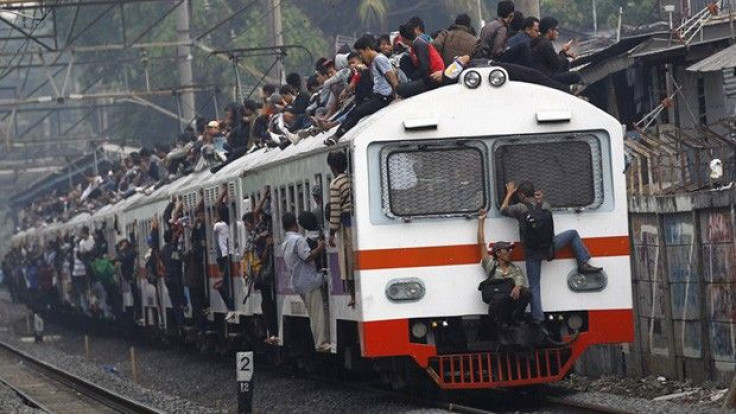Electrocution Threat To Deter 'Roof Surfers' On Indonesia's Crowded Trains

It is common to see the roofs of commuter trains in Indonesia crowded with people as they travel in and out of the capital of Jakarta.
State railway officials have tried a number of approaches to deter the illegal practice, including the installation of barbed-wire atop train cars, spraying paint on the roofs to identify transgressors later and hanging concrete balls to potentially bash in the skulls of so-called "roof surfers," but none have proven to be very effective.
Authorities have announced they will implement yet another deterrent that seeks to make roof-surfing even more dangerous; They plan to lower power lines over railways that could electrocute anyone riding above the trains.
While fare evaders make up a portion of roof surfers, many of them are ticketholders unable to find room in the overcrowded train cars, especially during rush hour.
Indonesia's railway system has been criticized as being poorly maintained, outdated and insufficient to meet demand, resulting in numerous delays and overcrowding.
Roughly 400,000 people commute into and out of Jakarta on a daily basis, well beyond the capacity of the current railway system.
For the thousands of urban poor living on the outskirts of the city, the trains are the cheapest form of transportation into the center.
But it is not simply a matter of poverty causing a flood of passengers to overburden the train system as the percentage of Indonesia's population below living below the poverty line was only slightly over 13 percent in 2010, less than the U.S. (15 percent).
Rather, it is Indonesia's public transit infrastructure, Jakarta's in particular, that is failing to meet the needs of Indonesian commuters, from the day laborer to the young business professional.
Jakarta, a city with a population over 10 million and an area some 50 square miles larger than Chicago, has a notoriously inept public transit system. It does not have a subway, and its streets are congested with thousands of taxis, pedicabs, cyclists and private cars.
It does have a public bus system that utilizes restricted lanes, but they primarily service commuters within the city center, which fails to solve the problem of getting people in and out of the city.
The obvious solution would appear to be to expand the railway system by adding more trains, an initiative transit authorities may be trying to fund by raising ticket prices 40 percent in October.
Of course, this just might have the side effect of convincing more people to try to avoid the fare by roof surfing. But with the threat of electrocution, it may not be worth the risk.
© Copyright IBTimes 2024. All rights reserved.











